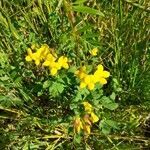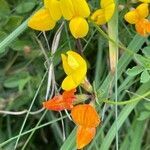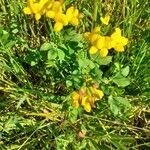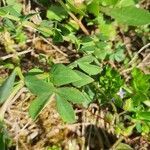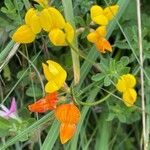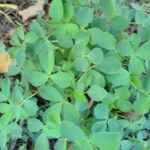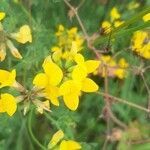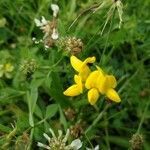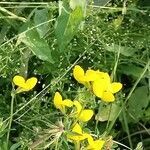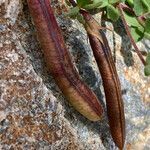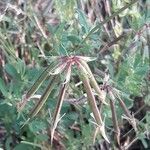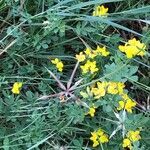Taprooted, usually ± glabrous perennial with prostrate to suberect stems to 6 dm; lvs subsessile, 5-foliolate, the lower pair of lfls evidently removed from the 3 crowded terminal lfls and resembling foliaceous stipules; lfls 5–15 mm, elliptic to oblanceolate, mostly 1.5–2.5 times as long as wide; fls mostly 4–8 together, in long-peduncled, head-like umbels from the upper axils; pedicels 1–3 mm; cal-tube 2.8–3.5 mm; cor mostly 10–16 mm, bright yellow, becoming orange and marked with brick-red; filaments unequal, the 5 longer dilated at the tip; fr 1.5–3.5 cm; 2n=24. Native of Europe, cult. as a forage-crop, and widely established in meadows and disturbed habitats in the U.S., common in our range. June–Aug.
Scarcely stoloniferous perennial; stems ± glabrous, ± solid, procumbent to ascending, woody at base. Lvs ± glabrous or sparsely to moderately hairy, sessile; leaflets obovate, acute, cuneate at base, (3)-5-15-(18) mm long, with inconspicuous lateral veins. Peduncles much > lvs, up to 90 mm long. Infl. (1)-2-7-flowered. Calyx ± glabrous or sparsely to moderately hairy; calyx teeth ± equal, narrowly triangular, ± = tube. Corolla yellow, 10-15 mm long; keel strongly arched with a fairly long, often somewhat incurved beak. Pod straight, rounded, not winged, 15-35 × 1.5-3 mm; seeds c. 1.5 mm diam.
Perennial herb, erect, up to 0.2 m? high; upright to spreading; ± glabrous. Leaves 5-foliolate; leaf rachis shorter than length of basal leaflets. Leaflets: basal ones ovate, apical leaflets obovate, apex cuspidate, both surfaces glabrous. Inflorescences 1-3-flowered umbels; peduncle 35-50 mm long. Calyx bluish green, glabrous, scarcely hairy at margins; hypanthium purple, ± 2 mm long, tube above insertion of stamens ± 2 mm long; lobes with rounded base, points subulate, ± 3 mm long. Flowering time Jan.?.
A herb which keeps growing from year to year. The stems are trailing or curve upwards. The stems are solid. The leaves have 5 entire blunt leaflets. The flowers heads can have 8 flowers. The flowers are pea-like with yellow petals and a reddish standard. The pods are cylinder shaped and become dark on maturity. They are 15-30 mm long.
